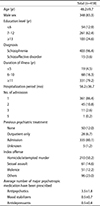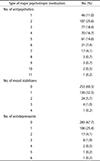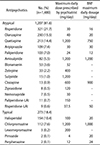Abstract
The National Forensic Hospital is the only forensic psychiatric hospital in Korea. As of January 2016, the average number of patients assigned to each psychiatrist is more than 120. In this situation, the role of psychopharmacologic treatment becomes very important. To investigate the prescription patterns of major psychotropic medications (i.e., antipsychotics, mood stabilizers, and antidepressants), we reviewed the medical records of the patients diagnosed with schizophrenia and schizoaffective disorder who were admitted in January 2016. The data from 418 patients (403 with schizophrenia and 15 with schizoaffective disorder) were retrospectively collected and analyzed. The average number of major psychotropic medications prescribed for each patient during hospitalization was as follows: antipsychotics, 3.5±1.8; mood stabilizers, 0.5±0.7; and antidepressants, 0.5±0.8. The three most frequently prescribed antipsychotics were risperidone (21.7%), olanzapine (15.5%), and quetiapine (14.4%). More than half of the patients (233, 55.9%) were prescribed an antipsychotic polypharmacy regimen. This study found that patients with schizophrenia and schizoaffective disorder in forensic psychiatric hospital tend to be prescribed many psychotropic medications.
Figures and Tables
References
1. Degl' Innocenti A, Hassing LB, Lindqvist AS, et al. First report from the Swedish National Forensic Psychiatric Register (SNFPR). Int J Law Psychiatry. 2014; 37:231–237.
2. Kim W, Bahk WM, Woo YS, et al. Polypharmacy in schizophrenic inpatients: the comparison between 1997 and 2003 in one university hospital. Korean J Psychopharmacol. 2005; 16:390–395.
3. Hwang IH, Kim D, Oh DY. Psychotropic prescription patterns for inpatients with schizophrenia: 10-year comparison in a university-affiliated hospital in South Korea. Korean J Biol Psychiatry. 2014; 21:49–56.
4. Stone-Brown K, Naji M, Francioni A, et al. Psychotropic prescribing in seriously violent men with schizophrenia or personality disorder in a UK high security hospital. CNS Spectr. 2016; 21:60–69.
5. Paton C, Lelliott P, Harrington M, et al. Patterns of antipsychotic and anticholinergic prescribing for hospital inpatients. J Psychopharmacol. 2003; 17:223–229.
6. British Medical Association. Royal Pharmaceutical Society of Great Britain. British National Formulary. London: BMJ Books & Pharmaceutical Press;2015.
7. Whicher E, Morrison M, Douglas-Hall P. ‘As required’ medication regimens for seriously mentally ill people in hospital. Cochrane Database Syst Rev. 2002; (2):CD003441.
8. Chang JG, Roh D, Kim CH. Recent trends of antipsychotics polypharmacy in schizophrenia. Korean J Psychopharmacol. 2013; 24:137–146.
9. Korean Medication Algortihm Project for Schizophrenia. The guideline of Korean medication algorithm for schizophrenia patients. Seoul: Committee for KMAP;2006.
10. American Psychiatric Association. Practice guidelines for the treatment of patients with schizophrenia. 2nd ed. St. Louis: American Psychiatric Association;2004.
11. Moore TA, Buchanan RW, Buckley PF, et al. The Texas Medication Algorithm Project antipsychotic algorithm for schizophrenia: 2006 update. J Clin Psychiatry. 2007; 68:1751–1762.
12. Kreyenbuhl J, Buchanan RW, Dickerson FB, et al. The Schizophrenia Patient Outcomes Research Team (PORT): updated treatment recommendations 2009. Schizophr Bull. 2010; 36:94–103.
13. National Institute for Health and Care Excellence. Psychosis and schizophrenia in adults: prevention and management (clinical guideline 178) [Internet]. London: National Institute for Health and Care Excellence;2014. cited 2014 Mar 1. Available from: http://guidance.nice.org.uk/CG178.
14. Galletly C, Castle D, Dark F, et al. Royal Australian and New Zealand College of Psychiatrists clinical practice guidelines for the management of schizophrenia and related disorders. Aust N Z J Psychiatry. 2016; 50:410–472.
15. Kane JM. The use of depot neuroleptics: clinical experience in the United States. J Clin Psychiatry. 1984; 45(5 Pt 2):5–12.




 PDF
PDF ePub
ePub Citation
Citation Print
Print








 XML Download
XML Download